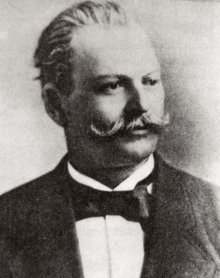Paul Mauser
Peter Paul von Mauser | |
|---|---|
 Peter Paul von Mauser | |
| Born | June 27, 1838 |
| Died | May 29, 1914 (aged 75) |
| Nationality | German Empire |
| Occupation(s) | Engineer, Weapon Designer |
| Known for | Development of distinctive Mauser action |
| Notable work | Gewehr 98 rifle 7.65×53mm Mauser and 7×57mm Mauser rifle cartridges |
| Relatives | Wilhelm Mauser, brother |
Peter Paul Mauser, after 1912 von Mauser, (June 27, 1838 – May 29, 1914) was a German weapon designer and manufacturer/industrialist.[1]
Biography
Mauser was born in Oberndorf am Neckar, in what was then the Kingdom of Württemberg. His father and his four older brothers were gunsmiths.[1]
Together with his brother Wilhelm Mauser, Peter Paul Mauser designed the Mauser Model 1871 rifle, the first of a successful line of Mauser rifles and pistols. The rifle was adopted as the Gewehr 71 or Infanterie-Gewehr 71 and was the first metal cartridge weapon of the German Empire. While Wilhelm handled this business side of the factory, Paul proved to be the more technically capable engineer.[1]
Peter Paul Mauser made significant contributions to bolt action rifle design and successfully combined and improved various bolt action engineering concepts.[2] The Mauser company bolt action development resulted in the Gewehr 98 and Karabiner 98k rifle series that were the latest in a line of Mauser bolt action rifles that started with the Mauser Model 1889 and were adapted in 1889 and the 1890s as service rifles by several countries. The bolt action design used for the Gewehr 98 was patented by Paul Mauser on 9 September 1895.
Peter Paul Mauser also designed the 7.65×53mm Mauser (1889) and 7×57mm Mauser (1892) rifle cartridges. These cartridges were high-performance service cartridge designs compared to other contemporary smokeless powder service cartridges such as the 8mm Lebel (1886), 8×50mmR Mannlicher (1890) and .303 British (1891).[3]
References
- ^ a b c De Haas, Frank (2003). "Mauser Models 71 &71/84". In Wayne Zwoll (ed.). Bolt Action Rifles (4 ed.). Iola, Wisconsin: Krause Publications. p. 123. ISBN 978-0-87349-660-5.
- ^ Five Supposed Mauser Firsts … That Weren’t
- ^ Mauser Rifles and Pistols by W. H. B. Smith
External links
